SEA LIONS AND HUMANS
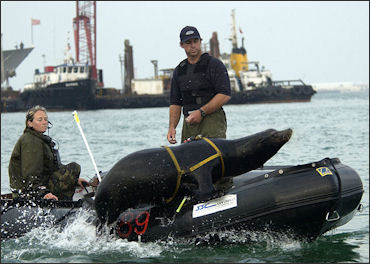
US Navy sea lions Shallow Water Intruder Detection
System (SWIDS) program
Nearly all pinnipeds have been hunted at one time or another for their meat, oil, ivory or fur. Leather is sometimes made from seals. Some species are still pursued while others are protected. Commercial sealers traditionally drove the seals to a designated area and killed them with blow to soft parts for their skulls. Most of the animals caught to do tricks in marine animal shows are sea lions.
In the Arctic the Inuit traditionally hunted seals by cutting a hole in the ice and waiting for a seal to show up. When a seal showed up it was harpooned. The Inuit ate the blubber and meat and used the skin for boots, clothing and cover for kayaks. Seal Penises are sought after in Chinese Medicine as an aphrodisiac.
California sea lions are widely used for entertainment and educational programs throughout the world because of their agility and trainability. They are commonly featured as performing animals in zoos, circuses and ocean park shows. They are easily trained and intelligent and have also been used by the U.S. Navy for retrieval programs, including search and rescue and retrieval of military hardware. They are also used to patrol areas in search of threats. [Source: Rebecca Price, Animal Diversity Web (ADW) /=]
California sea lions used to be hunted for their hides and for animal food. They are regarded as pests by some fishermen who blame them for seriously reducing stocks of commercially-valuable fish such as salmon. They also may interfere with nets used by fishermen. Occasionally California sea lions pose a problem for fishermen by stealing fish from their nets.
Websites and Resources: Animal Diversity Web (ADW) animaldiversity.org; National Oceanic and Atmospheric Administration (NOAA) noaa.gov; Fishbase fishbase.se; Encyclopedia of Life eol.org; Smithsonian Oceans Portal ocean.si.edu/ocean-life-ecosystems ; Monterey Bay Aquarium montereybayaquarium.org ; MarineBio marinebio.org/oceans/creatures
Seals and the Military
Sea lions are used in the U.S. military. The U.S. Navy’s Marine Mammal Program was established in the 1950s when Navy researchers attempted to improve torpedo design by studying dolphins. Stavros Atlamazoglou wrote in Business Insider: The program tested out a number of animals but found dolphins and sea lions to be the best suited for the mission. Their biological sonars enable them to detect things that electronic sonar might miss, such as enemy mines or lost equipment, and sea lions have sensitive hearing and acute eyesight that allows them to monitor the murkiest water for threats like enemy divers. [Source: Stavros Atlamazoglou, Business Insider, February 2, 2023]
_program.jpg)
US Navy sea lions Shallow Water Intruder Detection
System (SWIDS) program Some sea lions were sent to the Persian Gulf in advance of the U.S. invasion of Iraq in the early 2000s. As of 2007, there were 25 California sea lions and 74 dolphins at the U.S. Navy facility at Point Loma, California. Sea lions are particularly valued because they have great vision in poor light, superior hearing capabilities and can maneuver in tight spots. They are used near piers and anchored ships. They have been trained to find swimmers, place clamps on their legs and take an attached line to sailors awaiting above. This method can be used to retrieve downed pilots or snag scuba-diving terrorists. Sea lions have also been trained to mark underwater objects.
Dolphins and sea lions are on duty in waters off the submarine base in Kings Bay, Georgia and were mobilized in the Persian Gulf in the war in Iraq in 2003. Sea lions employed by the United States Marine Mammal Program have been trained to swim up behind enemy divers and immobilize their legs with cuffing devises so people on the surface can haul them up by rope.
See Separate Article DOLPHINS AND THE MILITARY ioa.factsanddetails.com
Seal Breaks into New Zealand Home, Chills on the Couch But Traumatizes Cat
In August 2022, curious young seal broke into a New Zealand home, harassed the resident cat, and hung out in the hallway for a couple of hours while the children slept upstairs, and did no dmage to the house. The Guardian reported: The Ross family of Mt Maunganui were more than a little surprised to find the New Zealand fur seal in their home, which is about 150 meters from the shore. Phil Ross, who happens to be a marine biologist, said it was unfortunate he was the only one not home at the time. “The big joke is that this is really the only family emergency where it would be useful to have a marine biologist in the house,” he said. “I really missed my time to shine.” [Source: Eva Corlett in Wellington, The Guardian, August 19, 2022]
Ross said his wife, Jenn, rose just before 6am on Wednesday to go to the gym. “As she got in the car, something barked from underneath and shuffled away. She thought it was someone’s dog … and didn’t really think too much of it.” She returned around 7am, opening the door to find “a cute little seal”. “It got a bit of a fright and humped its way down the hallway into the spare room.” Ross said the seal had managed to make its way through two catflaps to get into the home. He believes it had encountered the family’s territorial cat, Coco, outside, just after Jenn had left the property, and had likely been inside for an hour. “The cat would have gone to defend its territory and obviously the seal wasn’t as intimidated as some dogs are, so Coco must have bolted around the side of the house, into the catflap, and the seal must have followed her.”
Jenn woke their two children, Noah, 12, and Ari, 10, to come and see “their new pet”. “They thought it was cool and pretty exciting but were totally oblivious to the fact that … not many of their mates would have seals come to visit them in their houses.” The seal spent time in the spare room and on the couch before Jenn managed to usher it out the front door and into the garden. A Department of Conservation ranger turned up at 10am to take the seal back to the sea, after a busy morning of seal-related call-outs.
The seal, which the family nicknamed “Oscar” in a long tradition of giving seals that name in the community, proved to be polite company, Ross said, and thankfully had not defecated inside. “I think that would have been pretty terminal for the furniture.” Meanwhile, Coco the cat had scarpered to the neighbour’s house. On returning to its own home, it refused to go downstairs because it was “clearly pretty traumatised”. Ross said it was not unusual to see young seals roaming about in the area at this time of year, because the young ones were beginning to wean and head out on their own. “I guess, like all teenagers, they don’t necessarily make sensible decisions.”
Threatened Seals
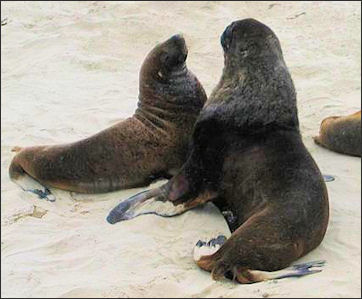
New Zealand sea lion "Humans have been killing seals for food since the Stone Age times, judging from ancient seal clubs and bones found along Denmark's Kattegat Strait," Roger Gentry wrote in National Geographic, "When an efficient way was found in the 1800s to rid fur seal hides of their outer guard hair, leaving only the soft durable underfur, millions of those animals were slaughtered for garments." Colonies of thousands of animals were exterminated in a few years. Today seals are mainly taken for "seal sticks," or penis bones, which are thought by some Asian cultures to be aphrodisiacs.
Many seals are lost when they drown in fishing nets. Of the world's 5,000 Hooker sea lions, 75 females were accidently drowned in a single year. Sometimes seals will gather around fishing nets where they feast on the fish, much to the dismay of the fisherman who sometimes play killer whale sounds to try and get rid of them. Sometimes fisherman shoot the seals and or scare them with away with explosives.
There have been reports of seal beachings similar to those of whales and porpoises. On the east coast of the United States sick baby hood seals washed up on beaches in 2006. One was found eating sand. Hooded seals are usually only found in Arctic waters.
In the late 1990s the number of sick and malnourished sea lions, seals and elephant seals along the northern coast of California increased. No one was sure why. Some scientists thought it was a consequence of overfishing or some other disruption of the food chain that deprived these marine mammals of e food they were used to getting.
Canada’s Annual Seal Hunt
Canada still holds an annual commercial seal hunt. In the mid 2000s, seal hunters regularly killed over 330,000 seals a year. In 2006, 355,000 were killed. That year Paul McCartney and his then-wife Heather posed with a seal pup in the Gulf of St. Lawrence. The figure is lower now. In 2016, the Atlantic hunt took about 70,000 harp and grey seals. Around 26,000 were killed in 2021.
According to the Humane Society of the United States: Canada's annual commercial seal hunt is the largest slaughter of marine mammals on the planet. Canada's commercial seal hunt occurs on the ice floes off Canada's East Coast in two areas: the Gulf of St. Lawrence (west of Newfoundland and east of the Magdalen Islands) and the "Front" (northeast of Newfoundland). Harp seals are the primary target and to a much smaller extent, hooded seals are also killed. Fully 97 percent of the harp seals killed are pups under just three months of age. [Source: Humane Society of the United States]
Sealing is an off-season activity conducted by fishermen from Canada's East Coast. They make, on average, a small fraction of their annual incomes from sealing — and the rest from commercial fisheries. Even in Newfoundland, where most sealers live, the government estimates there are less than 6,000 fishermen who actively participate in the seal hunt each year — less than one percent of the provincial population.
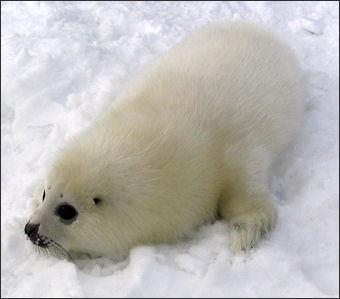
baby harp seal
The Canadian Marine Mammal Regulations that govern the hunt stipulate sealers may kill seals with wooden clubs, hakapiks (large ice-pick-like clubs) and guns. In the Gulf of St. Lawrence, clubs and hakapiks are the killing implement of choice, and in the Front, guns are more widely used (though clubs are frequently used at the Front to kill seals that have been shot and wounded). It is important to note that each killing method is demonstrably cruel. Because sealers shoot at seals from moving boats, the pups are often only wounded. The main sealskin processing plant in Canada deducts $2 from the price they pay for the skins for each bullet hole they find — therefore sealers are loath to shoot seals more than once. As a result, wounded seals are often left to suffer in agony — many slip beneath the surface of the water where they die slowly and are never recovered.
It is notable that in the 50 years Canada’s commercial seal hunt has been the subject of consistent veterinary scrutiny, not one report has ever suggested the seal hunt is acceptably humane. A 2007 review by Dr. Mary Richardson, a Canadian veterinary expert in humane slaughter methods, concluded that the commercial seal hunt is inherently inhumane because of the environment in which it operates and the speed at which the killing must be conducted. Also in 2007, a report by an international team of veterinary and zoology experts who studied the hunt concluded that both clubbing and shooting of seals in Canada are inhumane and should be prohibited. The report noted a general failure to comply with regulations by sealers and a failure to enforce the regulations by authorities.
In recent years, hundreds of thousands of seals have been killed annually in the commercial seal hunt. More than one million seals were slaughtered in one five year period in recent years. These kill levels are among the highest witnessed in Canada in half a century. The last time seals were killed at this rate — in the 1950s and '60s — the harp seal population was reduced by as much as two-thirds. Moreover, the actual number of seals killed is likely higher than the number reported. Many seals are shot at and injured in the course of the hunt and studies suggest that a significant number of these animals slip beneath the surface of the water, where they die slowly and are never recovered.
Seals are killed primarily for their fur, which is used to produce fashion garments and other items. There is a small market for seal oil (both for industrial purposes and for human consumption) and seal penises have been sold in Asian markets as an aphrodisiac. There is almost no market for the meat, so seal carcasses are normally left to rot on the ice. Senior Canadian government representatives define the seal slaughter as “primarily a fur hunt.”
Defending the Canadian Seal Hunt
Tristin Hopper wrote in the National Post: Hunting seals may ignite outrage abroad, but it is one of the few issues supported by virtually every Canadian MP, regardless of region or party. It’s more humane than most opponents think. A persistent image in anti-seal hunt videos is of a sealer running across an ice floe to repeatedly club a prone seal with a hakapik. A running, club-wielding hunter looks more craven, which is probably why the image is an anti-sealing favourite. But what’s being captured is a hunter diligently carrying out a humane practice called the “three step” process. Step one is “stunning,” when the seal is usually hit with a bullet to the head. Steps two and three then involve ensuring that the animal is dead by crushing its skull and severing key arteries. A running hunter is generally a good thing: In cases where a seal isn’t killed instantly, some urgency is reasonable to ensure that the animal’s suffering is ended quickly. [Source:Tristin Hopper, the National Post, April 3, 2018]
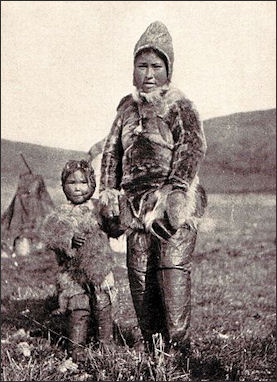
seal skin clothes Nobody is killing those adorable white baby seals. This is, bar none, the most persistent and widespread myth about the Canadian seal hunt. Every year, anti-seal hunt literature is almost guaranteed to include images of white-coated infant harp seals. This is despite the fact that Canada has banned the killing of white-coated seals since 1987, and that the Inuit never killed white coats. Even if organizations don’t trade in images of white seals, they will still lean heavily on the term “baby seals.” “Each spring, the Canadian government authorizes fishermen to club or shoot to death hundreds of thousands of baby seals for their fur,” writes the Humane Society of the United States. This is a reference to the fact that the vast majority of harp seals killed are between one and 3.5 months old. However, some context might be in order. Those rotisserie chickens at the grocery store were likely alive for only 40 days. The average pack of bacon comes from a pig that was only on earth for four months.
Another persistent myth is the notion that Canadians are somehow wiping seals off the planet. According to one leaflet from Humane Society International, Canada’s “seal slaughter” is “not sustainable.” But Canadian seals are doing absolutely fine. Harp seals form the majority of the Atlantic hunt, and in 2012, the Canadian government estimated there were 7.7 million of them on the Atlantic coast. Harp seal populations did hit historic lows in the mid-20th century, dropping as low as 1.5 million in 1978. But they’ve now rebounded so successfully that their populations are almost as large as they were when much of Canada was still New France.
Banning the Canadian Seal Hunt Hurts the Inuit
The Inuit are indigenous people of northern Canada, Greenland and the Arctic. They are sometimes called Eskimos. CBC-TV reported: Animals rights groups have been fighting since the 1960s to shut down the sealskin trade. Using graphic campaigns featuring fluffy seal pups being bludgeoned by hunters, opposition to seal hunting mounted. In 1983, Greenpeace and other groups were finally successful in getting the European Union to ban sealskin products made from white coat harp seal pups. [Source: CBC-TV, January 7, 2018]
Even though the legislation targeted only one kind of sealskin, the campaigners ruined the reputation for all types of sealskin. At the time, little thought was given to the impact the ban would have on the Inuit. Although the Inuit were exempt from the ban, the market for sealskin evaporated. A year later, the average income of an Inuit seal hunter in Resolute Bay fell from 53 thousand dollars to one thousand dollars. Suicide rates were already climbing in Inuit communities and spiked to become the highest in the world.
Inuit seal hunters hunt all over the Canadian Arctic as well as Alaska, Greenland and Russia. They Few people outside of the Arctic realize how crucial seals are to the Inuit economy and way of life. never hunted the baby whitecoat harp seal pups targeted by the anti-sealing campaigns — illegal in Canada since 1987. They hunt mostly ringed seals, as well as harp seals, that are adults by the time they’ve migrated that far north.
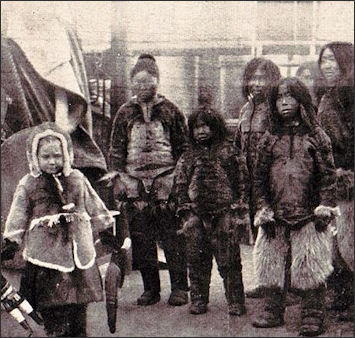
seal skin clothes Seal meat is lean with less than two percent fat. It's also rich in iron, zinc, vitamins A, D, B and C. It's a free, local and inexpensive food source that offers much better nutrition than what you can often buy in Arctic stores. As Arnaquq-Baril points out, food is expensive in the Arctic and Canada’s Inuit communities are the most food insecure in the country. Inuit require the fur to stay warm. The skin is also used for waterproof, biodegradable clothing such as boots, mittens and hats which can be sold internationally.
Since the international market for sealskin collapsed in the 1980s, it’s been difficult for Inuit designers to sell their wares. The sealskin market is an important income to the Inuit Inuit have few economic options and the income from seal hunting supports their lifestyle. Although Inuit hunt often more seals annually than southern Canadian hunters, they hunt on a small scale consistently year-round and sell their skins to government officers who take them to international markets. Commercial sealing has been part of their livelihood for over a century. The money allows them to buy gas fuel and other hunting supplies so they are able to go out and hunt for their community.
Putin Curbs 'Bloody' Seal Hunt
In 2009, when he was prime minister, Vladimir Putin said Russia was ending its seal hunt, calling it a "bloody industry." The Globe and Mail reported: The decision comes as the European Union edges toward banning the trans-shipment of seal products, a move that could stop the Atlantic seal hunt for good. [Source: Oliver Moore, Globe and Mail, March 11, 2009]
Russia has stopped the killing of whitecoats, the youngest seals, and has now pledged to protect older seals as well, though it did not give a timeline. "It is clear that [our hunt]should have been banned a long time ago," Mr. Putin said, according to a statement distributed yesterday by the embassy in Ottawa. Russia's Natural Resources Minister, Yury Trutnyev, called seal hunting "one of the most inhumane types of hunting in the world, which is banned in the vast majority of developed states."
The statement did not spell out whether Russia, which is a market for Canadian seal pelts, would continue to allow pelts to be imported. Anti-sealing advocates dispute the size of the Russian market but a Newfoundland processor said in 2007 that the country was the No. 1 customer for his products, with China not far behind.
"What this does show is the global momentum toward ending seal hunting," said Rebecca Aldworth, with Humane Society International-Canada. "Citizens all over Russia have been calling for an end to the seal hunt for many, many years. I wish the Government of Canada would be as responsive to its citizens. The overwhelming majority have been calling for an end."
90,000 Seals Clubbed in Namibian Seal Hunt
Namibia holds an annual commercial seal hunt between July 1 and Nov. 15. In 2011, the hunt was held despite objections by animal welfare groups. Hunters are expected to club over 90,000 seals, including 85,000 pups.Namibia is one of only a few remaining countries with a commercial seal harvest. The government argues that the seal population needs to be controlled to protect fish stocks. However, animal rights activists say the practice is inhumane and outdated. [Source: Tawanda Kanhema The Times of London, July 7, 2011]
Seals are hunted for skins, fur and meat, and seal genitals are sold as traditional medicines and aphrodisiacs in Asia. Animal rights groups like Fur Free SA and a newly formed organisation, The Seals of Nam, have raised their voices in protest, objecting to the violent manner in which baby seals are clubbed to death during the culling operation, which ends with exports of pelts to Australia for use in the manufacturing of fur coats and local extraction of seal oil for industrial use.
Activist Francois Hugo of Seal Alert South Africa said last week that he had made a bid to buy out the company that purchases the Namibian seal pelts, effectively halting the hunt. Hugo said that clubbing an animal to death is cruel, criminal and in defiance of international animal protection laws. He also challenged the Namibian government's claim that the hunt maintained healthy seal populations, saying that in the past whole colonies had been devastated.
Namibia's seals number about 900,000 and live on a dozen remote, rocky islands off the coast of the sparsely populated southern African country. Several large colonies of seals lie south of Henties Bay, a major tourist destination and the mecca of Namibia’s fishing industry.The hunt takes place under clandestine circumstances to avoid the glare of publicity — and to avoid upsetting tourists.
Namibian Seal Hunt Encouraged by Fishing Industry
The Namibian government has said seals consume 900,000 tons of fish each year, more than a third of the fishing industry's catch, and that the cull is needed to protect fisheries. The Times reported: Animal welfare groups counter that most of the seals killed are still-nursing pups. AJ Cady of the International Fund for Animal Welfare said that the industry is "collapsing" worldwide, citing a recent European Union ban on the import of seal products combined with the global economic downturn. In this year's Canadian harvest, sealers killed less than a third of their quota on weak demand. "The great question here is who is really buying these things?" Cady said. "The cruelty is so obvious." [Source: Tawanda Kanhema The Times of London, July 7, 2011]
The Namibian government’s position on seal population control is largely influenced by fishing interests, and Esau said the harvesting of seals is meant to reduce competition for fish between fisheries and the seal population. The government claims that pilchard harvests have gone up since the culling of seals began.
Namibia’s Minister of Fisheries and Marine Resources, Bernard Esau, said his ministry had received complaints from Namibian fisheries, particularly holders of long-line fishing rights, that seals were consuming nearly half of their catch and unhooking nets from their fishing boats. “Long-line fishermen are faced with seals following their vessels and unhooking their catch from the fishing vessels,” Esau said, “There are a lot of complaints from our long line rights holders, more than 50 percent of their fish is being unhooked by seals. “There are close to a million seals in our waters and because the colonies have grown, we need to reduce this to a manageable population.”
The Namibian government estimates that seals consume 900,000 tonnes of fish a year, close to third of the fishing industry’s annual catch. Namibia’s fishing industry is the second largest contributor to the country’s GDP and ranks among 10 of the world’s largest fishing industries.
Seals Listed as Endangered Because of Global Warming Concerns
In December 2010, the U.S. government on proposed listing two seals that depend on sea ice as threatened species because of the projected loss of ice from climate warming. The National Oceanic and Atmospheric Administration will seek to list ringed seals found in the Arctic Basin and the North Atlantic and two populations of bearded seals in the Pacific Ocean as threatened under the Endangered Species Act. [Source: AP, December 4, 2010]
Ringed seals are the main prey of polar bears, which were listed as threatened by the U.S. Fish and Wildlife Service in 2008. For ringed seals, the proposed listing also cites the threat of reduced snow cover. NOAA climate models were used to predict future sea ice conditions. The Center for Biological Diversity petitioned to list the seals in 2008 and later sued to force a decision on additional protections.
"We're pleased that NOAA is following the science and the law in recognizing the reality of what global warming is doing to the Arctic and its species," said Brendan Cummings, an attorney for the Center for Biological Diversity.
Ringed seals can live in completely ice-covered waters, using stout claws to dig and maintain breathing holes. Young ringed seal pups cannot survive in water. They are susceptible to temperature stresses until they grow a blubber layer and shed their lanugo, the white, wooly coat they're born with. Early breakup of sea ice threatens lairs during critical rearing periods when pups are too young to survive in water. Warming can expose lairs and make pups vulnerable to polar bears and Arctic foxes.
Ringed seals have a large population, Cummings said, but the entire population is dependent on sea ice, a habitat that is disappearing. "They're incredibly well-adapted to life in the Arctic, but what they're not adapted to is rain on snow and the lack of ice," Cummings said. There is little chance they can survive by simply abandoning ice and taking up residence on shore, he said."This is an animal that essentially never comes to shore," he said. "They evolved on the ice. Absent the ice, there's nowhere to go."
Bearded seals give birth and rear pups on drifting pack ice over shallow waters where prey is abundant. When females give birth, they need ice to last long enough in the spring and early summer to successfully reproduce and then molt, or shed and grown back their fur. "What we're seeing for them is a shrinkage of that ice season," Cummings said.
Image Sources: Wikimedia Commons, NOAA
Text Sources: Animal Diversity Web (ADW) animaldiversity.org; National Oceanic and Atmospheric Administration (NOAA) noaa.gov; Wikipedia, National Geographic, Live Science, BBC, Smithsonian, New York Times, Washington Post, Los Angeles Times, The New Yorker, Reuters, Associated Press, Lonely Planet Guides and various books and other publications.
Last Updated June 2023

